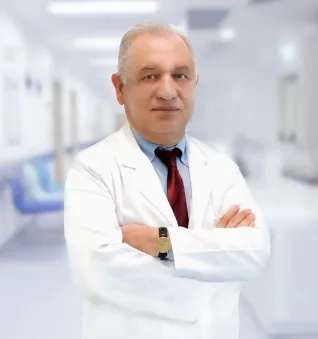Alo Yeditepe
Alo Yeditepe
Breast Cancer Diagnosis and Treatment Methods
The Size of the Tumor in Breast Cancer Affects Both the Stage and the Treatment
General Surgery Specialist Prof. Dr. Neşet Köksal, emphasizing the significance of the tumor size in the stages and treatment of breast cancer, stated, "The earlier and smaller the tumor is diagnosed in breast cancer, the higher our expectations from the treatment. When diagnosed early, the treatment success rate is nearly 100 percent. However, in advanced breast cancer without organ spread, treatment success rates can reach up to 90 percent"
General Surgery Specialist Prof. Dr. Neşet Köksal, reminding that breast cancer affects one million women worldwide every year, emphasized that the goal is to diagnose breast cancer before a mass forms through awareness and education campaigns on breast cancer on every platform globally. Prof. Dr. Köksal mentioned that, even today, patients often consult a doctor after detecting a mass, stating, "After detecting a mass in these patients, they want to learn how the size of the mass affects the treatment and conduct research on this matter.".
"The Rate of Proliferation in Breast Cancer is Typically Around 6 Months."
"Emphasizing that the tumor size in breast cancer significantly influences both the stage and the treatment of breast cancer," said General Surgery Specialist at Yeditepe University Koşuyolu Hospital, "When the tumor size is small during the diagnosis of breast cancer and the diagnosis is made early, our expectations from the treatment increase, and the patient can return to normal life more quickly," he spoke. Our expert pointed out that the process of cancer cell proliferation is different from normal cell structure and continues to proliferate uncontrollably. "The growth rates of different cancer types vary. Some cancer types progress faster, while others progress more slowly. To express this proliferation rate, we use a term called 'double time' or doubling time. This term represents the time it takes for a cancer to double in size. That is, the time it takes for one cell to become two cells, or for a one-centimeter tumor to reach two centimeters. Although there are various factors that affect the growth rate of breast cancer, this period is generally around 6 months. The time it takes for a tumor in breast cancer to reach approximately one centimeter in size can vary between 2 and 5 years."
“The Age Factor is also Important in the Course of Breast Cancer”
Our expert, emphasizing that there are many factors influencing the growth rate of cancer, continued: 'Age comes at the forefront of these factors. For example, breast cancers emerging in individuals under the age of 40 grow faster and become more aggressive. It is also known that breast cancers occurring before menopause grow faster. In individuals with a family history of breast cancer or those receiving hormone therapy after menopause, growth is also faster. In the pathological evaluation of the tumor, we also look at some parameters that provide information about the rate of proliferation. In cases where the differentiation or proliferation index in cancer cells is high, breast cancer tends to grow faster.
“As the Tumor Size Increases, Increased Spread to Regional Lymph Nodes is Accepted.”
Therefore, emphasizing the vital importance of early diagnosis in breast cancer, the general surgery specialist highlighted that the chance of successful treatment in the early stages of breast cancer is almost 100%. Our specialist continued with the following words on the subject:
"If the tumor size is below 2 centimeters, despite the spread to the underarm lymph nodes, we define it as an early stage breast cancer. If the tumor size is between 2-5 centimeters, the condition of the underarm lymph nodes becomes important. If there is no disease in the lymph nodes, we still consider it an early stage. However, if the tumor size is between 2-5 centimeters and there is spread to the lymph nodes, or if the tumor size is above 5 centimeters, we understand that the disease has progressed without checking the lymph nodes' condition, and we define it as locally advanced breast cancer. If there is organ spread, such as to the liver or lungs, regardless of the tumor size, we now consider it metastatic, meaning advanced, breast cancer."
"Our expert stated that as the tumor size increases, the likelihood of regional lymph node spread or organ metastases also increases. In some studies, it has been found that the probability of underarm lymph node spread in breast cancers with a size of 1cm and below is around 10%, while this rate can go up to 70% in cancers with a size above 5cm. However, the relationship between tumor size and spread to the underarm lymph nodes does not increase proportionally. This indicates that there are other factors, such as molecular characteristics, that influence the spread in addition to tumor size," said our expert.
"The Size of the Tumor Also Shapes the Treatment"
The methods we use in the treatment of breast cancer can be categorized into three groups. Surgical treatment, chemotherapy, hormone therapy, and drug treatments known as targeted therapy, as well as radiotherapy, also known as radiation therapy. While surgical treatment and radiotherapy provide local control of the disease, our expert, reminding that drug treatments target systemic therapy, explained how early-stage affects the treatment: "Each applied treatment may have undesired side effects that can disrupt the quality of life. If breast cancer is detected in a small size and at an early stage, surgical treatment and radiotherapy providing local control may be sufficient. For example, in the majority of breast cancers detected below 1cm, there may not be a need for chemotherapy, and the patient can be spared from the side effects of treatment. In addition to local treatments, if the cancer is hormone-sensitive, hormone therapy is applied, and if the patient benefits from targeted therapy, it is added to the treatment."
"We prefer to preserve the breast if it is suitable for the patients."
Our expert, emphasizing the significant role of surgical treatment in breast cancer, continued with the following words: "Generally, when applying surgical treatment to the breast, we try to preserve the breast as much as possible. This is because, initially, patients tend to believe that removing the cancerous breast will cure the disease. However, studies have shown no difference in terms of recurrence or survival between breast-conserving surgery, where the breast is preserved, and mastectomy, where the breast is removed."
“Our goal is to plan the patient's treatment and preserve their quality of life”
"While planning the surgical treatment for breast cancer, we aim to treat the cancer on one hand and, on the other hand, preserve the patient's quality of life," our expert said, continuing: "It is important not to forget that the breast is a significant organ for women. In breast cancer surgery, for suitable patients, we prefer breast-conserving surgical treatment methods, where we preserve the breast and remove the tumor along with the surrounding breast tissue. However, the cosmetic results that will arise during this process should also be acceptable. The volume of the breast is as crucial as the size of the tumor for breast-conserving surgery. For a 3 cm tumor in a small breast, breast-conserving surgery may not yield a good cosmetic result, while for a 5 cm tumor in a large breast, breast-conserving surgery may provide a satisfactory cosmetic result. Even if the tumor size is small, sometimes there may be tumors in multiple places within the breast. In such cases, instead of breast-conserving surgery, we prefer subcutaneous mastectomy, where the entire breast tissue is removed while preserving the nipple and breast skin, and reconstruction of the breast using various methods. In today's breast cancer surgical treatment, oncoplastic surgery, which we define as methods that do not compromise the patient's quality of life along with cancer treatment, is increasingly being used."
“The size directly influences the applied treatment.”
Professor Dr. Neşet Köksal, emphasizing that the tumor size directly affects the axillary surgery, stated, "Although it may be necessary to perform it when needed, the most discomforting condition for the patient after breast surgery is arm lymphedema that occurs after the removal of axillary lymph nodes, and finding solutions to these issues is quite challenging. Therefore, during breast cancer surgery, we prefer to preserve the axillary lymph nodes as much as possible. In smaller sizes, we generally observe less spread in the axillary lymph nodes, and in these cases, we content ourselves with removing 2-3 marked axillary lymph nodes, a procedure known as sentinel lymph node biopsy. Nowadays, even if there is no spread beyond the lymph node in one or two sentinel lymph nodes in patients who have undergone breast-conserving surgery, we avoid removing the axillary lymph nodes in these patients. As the size increases, the involvement of axillary lymph nodes becomes more significant. Therefore, the size is a factor that directly influences the surgery we apply to the axillary lymph nodes."
“Where and how the treatment will begin is very important”
Yeditepe University Hospitals General Surgery Specialist Prof. Dr. Neşet Köksal, stating that patients confront the diagnosis initially after it is made, said, "It can be a bit daunting and frightening for patients at first. After accepting this, they enter into a quest of 'what to do with this disease, how to apply treatment, and where to apply this treatment.' After the diagnosis of breast cancer, the patient's age, menopausal status, family history, the presence of genetic differences, the stage of the disease, the size of the tumor, whether it is solitary or multiple, its proximity to the nipple, breast structure, and the molecular characteristics of the tumor are evaluated, and then a treatment plan is made. This planning is determined after evaluation by a council consisting of a general surgery specialist, medical oncology specialist, radiation oncologist, radiologist, and pathologist. During this planning, the patient is consulted, and their involvement in the decision-making process is sought. In this way, decisions on whether to start treatment with surgery, chemotherapy, or targeted therapy, and if surgery is the starting point, what kind of surgical treatment will be applied, and what procedure will be performed for axillary lymph nodes, should be made together with the patient through discussion. It is important to inform the patient accurately on these matters and for them to seek care from a reputable and appropriate facility. It should not be forgotten that the treatment of breast cancer diagnosed early is nearly 100%, and for locally advanced breast cancers, it is around 85%. Patients lead a problem-free life for many years in these cases," he explained.
About
Faculty and Year of Graduation:
Ege University Faculty of Medicine, 1980
”
See Also
- Does Secondhand Smoke Increase the Risk of Breast Cancer?
- What is Gallbladder Surgery?
- Colorectal Cancers and Treatment Methods
- Patched Solution for Umbilical Hernia
- What are the Symptoms and Treatment Methods of Cirrhosis?
- 3 Major Developments Shaping Treatment in Colon Cancer
- Can Weight Loss Despite Not Dieting Be a Sign of Cancer?
- Serious Risk Factor for Colon Cancer: Heredity
- He Came to Turkey to Get Rid of the Colostomy Bag
- Does Breast Cancer Risk Decrease During Pregnancy and Breastfeeding?
- Breast Cancer Incidence Age Is Decreasing Day by Day
- Age of Breast Cancer Prevalence Falls, yet Mortality Declines
- Liver Cancer (Tumor) and Treatment
- Gallbladder Stones
- What Is Appendicitis?
- Questions About Gastroenterology Surgery
- What are the Types of Obesity Surgeries?
- Questions About Obesity Surgery
Alo Yeditepe





